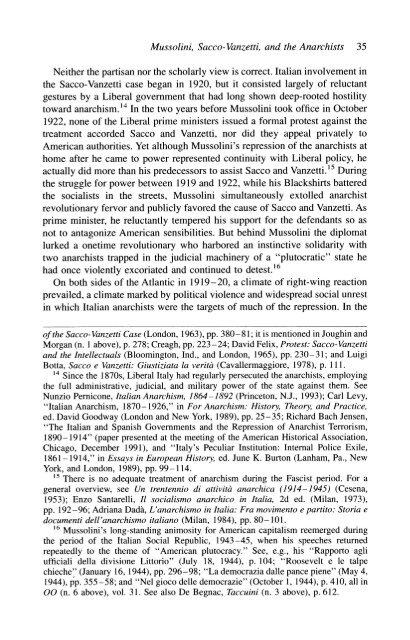Mussolini, Sacco-Vanzetti, and the Anarchists: The ... - Libcom
Mussolini, Sacco-Vanzetti, and the Anarchists: The ... - Libcom
Mussolini, Sacco-Vanzetti, and the Anarchists: The ... - Libcom
Create successful ePaper yourself
Turn your PDF publications into a flip-book with our unique Google optimized e-Paper software.
<strong>Mussolini</strong>, <strong>Sacco</strong>-<strong>Vanzetti</strong>, <strong>and</strong> <strong>the</strong> <strong>Anarchists</strong> 35<br />
Nei<strong>the</strong>r <strong>the</strong> partisan nor <strong>the</strong> scholarly view is correct. Italian involvement in<br />
<strong>the</strong> <strong>Sacco</strong>-<strong>Vanzetti</strong> case began in 1920, but it consisted largely of reluctant<br />
gestures by a Liberal government that had long shown deep-rooted hostility<br />
toward anarchism.'4 In <strong>the</strong> two years before <strong>Mussolini</strong> took office in October<br />
1922, none of <strong>the</strong> Liberal prime ministers issued a formal protest against <strong>the</strong><br />
treatment accorded <strong>Sacco</strong> <strong>and</strong> <strong>Vanzetti</strong>, nor did <strong>the</strong>y appeal privately to<br />
American authorities. Yet although <strong>Mussolini</strong>'s repression of <strong>the</strong> anarchists at<br />
home after he came to power represented continuity with Liberal policy, he<br />
actually did more than his predecessors to assist <strong>Sacco</strong> <strong>and</strong> <strong>Vanzetti</strong>.'5 During<br />
<strong>the</strong> struggle for power between 1919 <strong>and</strong> 1922, while his Blackshirts battered<br />
<strong>the</strong> socialists in <strong>the</strong> streets, <strong>Mussolini</strong> simultaneously extolled anarchist<br />
revolutionary fervor <strong>and</strong> publicly favored <strong>the</strong> cause of <strong>Sacco</strong> <strong>and</strong> <strong>Vanzetti</strong>. As<br />
prime minister, he reluctantly tempered his support for <strong>the</strong> defendants so as<br />
not to antagonize American sensibilities. But behind <strong>Mussolini</strong> <strong>the</strong> diplomat<br />
lurked a onetime revolutionary who harbored an instinctive solidarity with<br />
two anarchists trapped in <strong>the</strong> judicial machinery of a "plutocratic" state he<br />
had once violently excoriated <strong>and</strong> continued to detest.'6<br />
On both sides of <strong>the</strong> Atlantic in 1919-20, a climate of right-wing reaction<br />
prevailed, a climate marked by political violence <strong>and</strong> widespread social unrest<br />
in which Italian anarchists were <strong>the</strong> targets of much of <strong>the</strong> repression. In <strong>the</strong><br />
of <strong>the</strong> <strong>Sacco</strong>-<strong>Vanzetti</strong> Case (London, 1963), pp. 380-8 1; it is mentioned in Joughin <strong>and</strong><br />
Morgan (n. 1 above), p. 278; Creagh, pp. 223-24; David Felix, Protest: <strong>Sacco</strong>-<strong>Vanzetti</strong><br />
<strong>and</strong> <strong>the</strong> Intellectuals (Bloomington, Ind., <strong>and</strong> London, 1965), pp. 230-31; <strong>and</strong> Luigi<br />
Botta, <strong>Sacco</strong> e <strong>Vanzetti</strong>: Giustiziata la verita (Cavallermaggiore, 1978), p. 111.<br />
14 Since <strong>the</strong> 1870s, Liberal Italy had regularly persecuted <strong>the</strong> anarchists, employing<br />
<strong>the</strong> full administrative, judicial, <strong>and</strong> military power of <strong>the</strong> state against <strong>the</strong>m. See<br />
Nunzio Pernicone, Italian Anarchism, 1864-1892 (Princeton, N.J., 1993); Carl Levy,<br />
"Italian Anarchism, 1870-1926," in For Anarchism: History, <strong>The</strong>ory, <strong>and</strong> Practice,<br />
ed. David Goodway (London <strong>and</strong> New York, 1989), pp. 25-35; Richard Bach Jensen,<br />
"<strong>The</strong> Italian <strong>and</strong> Spanish Governments <strong>and</strong> <strong>the</strong> Repression of Anarchist Terrorism,<br />
1890-1914" (paper presented at <strong>the</strong> meeting of <strong>the</strong> American Historical Association,<br />
Chicago, December 1991), <strong>and</strong> "Italy's Peculiar Institution: Internal Police Exile,<br />
1861-1914," in Essays in European History, ed. June K. Burton (Lanham, Pa., New<br />
York, <strong>and</strong> London, 1989), pp. 99-114.<br />
'5 <strong>The</strong>re is no adequate treatment of anarchism during <strong>the</strong> Fascist period. For a<br />
general overview, see Un trentennio di attivita anarchica (1914-1945) (Cesena,<br />
1953); Enzo Santarelli, Il socialismo anarchico in Italia, 2d ed. (Milan, 1973),<br />
pp. 192-96; Adriana Dada, L'anarchismo in Italia: Fra movimento e partito: Storia e<br />
documenti dell'anarchismo italiano (Milan, 1984), pp. 80-101.<br />
16 <strong>Mussolini</strong>'s long-st<strong>and</strong>ing animosity for American capitalism reemerged during<br />
<strong>the</strong> period of <strong>the</strong> Italian Social Republic, 1943-45, when his speeches returned<br />
repeatedly to <strong>the</strong> <strong>the</strong>me of "American plutocracy." See, e.g., his "Rapporto agli<br />
ufficiali della divisione Littorio" (July 18, 1944), p. 104; "Roosevelt e le talpe<br />
chieche" (January 16, 1944), pp. 296-98; "La democrazia dalle pance piene" (May 4,<br />
1944), pp. 355-58; <strong>and</strong> "Nel gioco delle democrazie" (October 1, 1944), p. 410, all in<br />
00 (n. 6 above), vol. 31. See also De Begnac, Taccuini (n. 3 above), p. 612.

















